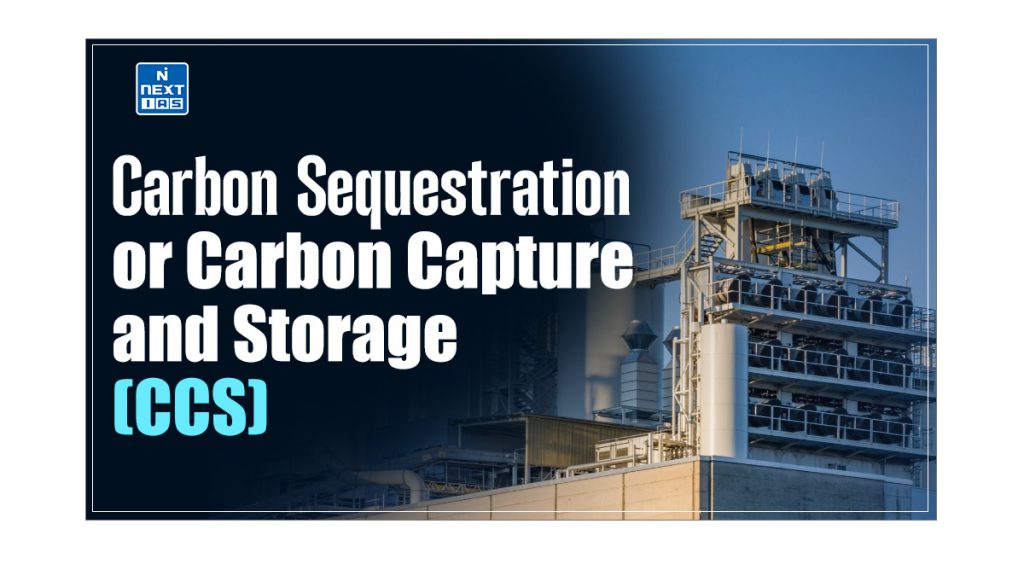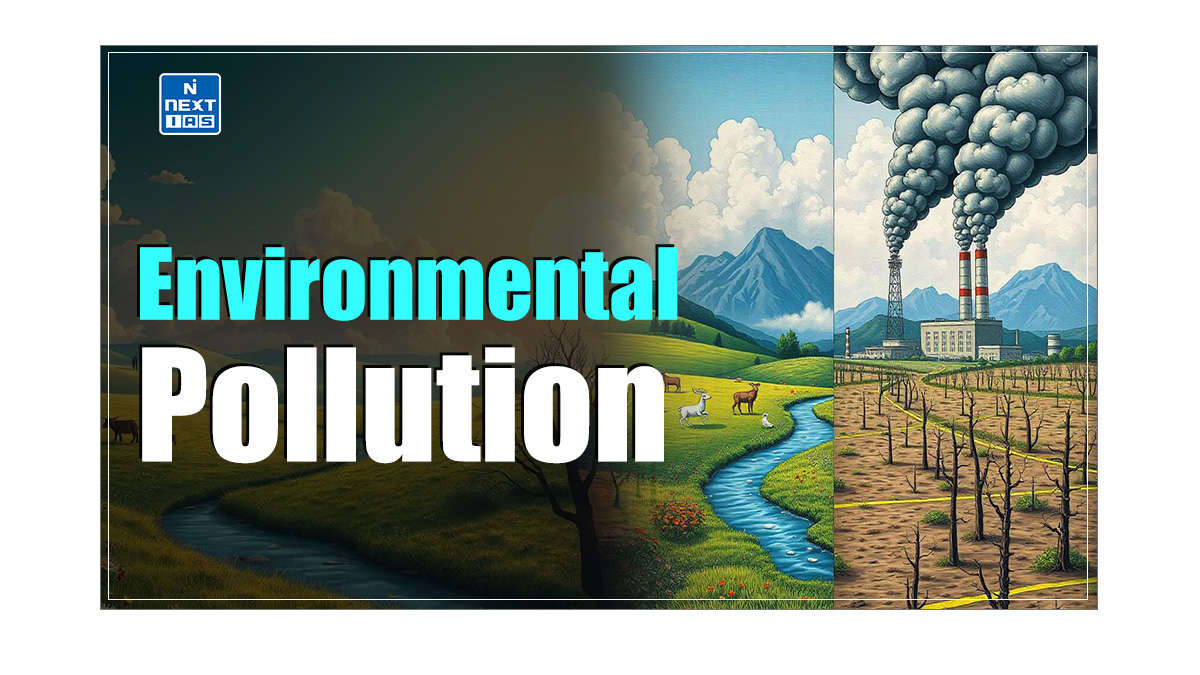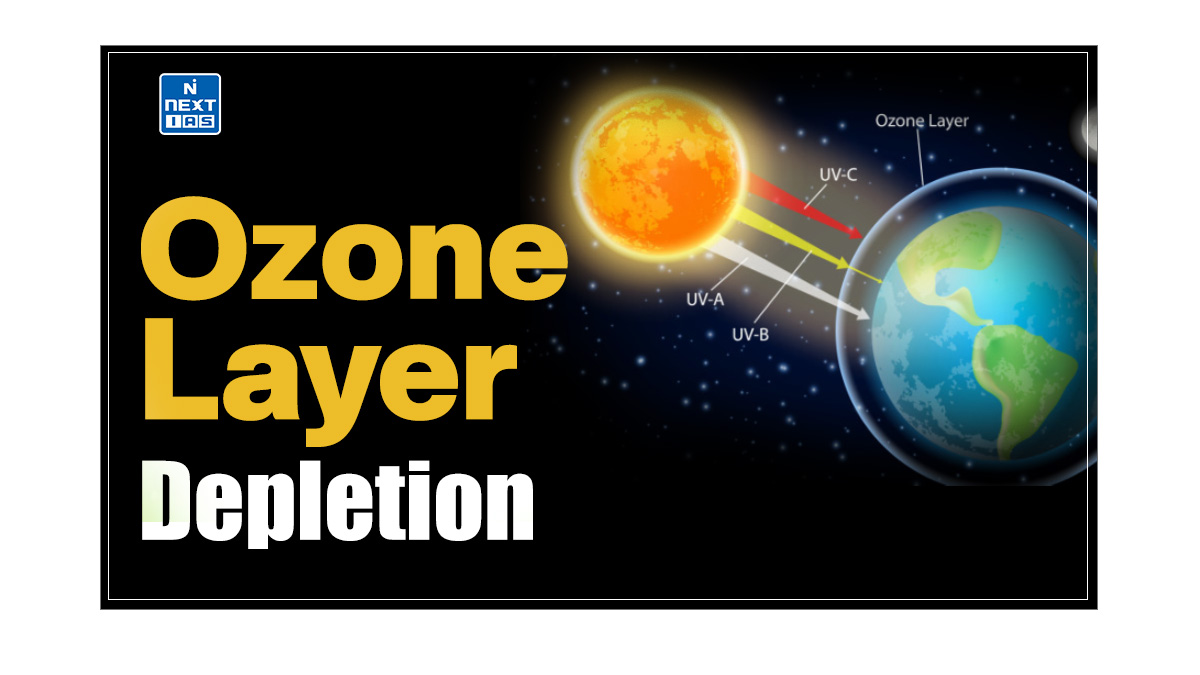
Carbon Sequestration, also known as Carbon Capture and Sequestration (CCS), has emerged as a critical tool for addressing climate change. This technique has gained attention as a viable solution to reduce greenhouse gas emissions and mitigate the impacts of global warming. This article aims to provide a comprehensive overview of Carbon Sequestration or Carbon Capture and Sequestration, its meaning, mechanism, types, advantages, challenges and other related concepts.
What is Carbon Sequestration or Carbon Capture and Sequestration (CCS)?
- Carbon Sequestration, also known as Carbon Capture and Sequestration (CCS), is the process of capturing carbon dioxide (CO2) from the atmosphere and storing it in some sinks like plants, soils, geologic formations, or the ocean.
- It can occur both naturally and artificially.
- It must also be noted that other forms of carbon, not just CO2, are stored during this sequestration process.
- However, it typically refers to the storage of carbon that has the immediate potential to become carbon dioxide gas.
Steps in Carbon Sequestration
The process of Carbon Sequestration or Carbon Capture and Sequestration (CCS) consists of three steps:
- Capturing Carbon dioxide,
- Transporting Carbon dioxide, and
- Securely storing Carbon dioxide, underground in depleted oil and gas fields or deep saline aquifer formations.
These steps of Carbon Capture and Sequestration (CCS) have been discussed below:
Capturing Carbon dioxide
- In the process of capture, carbon dioxide is removed or separated from other gases in power plants and industries, such as steel, cement, etc.
- This captures 90% of carbon dioxide emissions.
- The capture is done by three types:
Pre-Combustion Capture of Carbon dioxide
- In this type of capture, the CO2 is captured from a relatively pure exhaust stream as the fossil fuel is partially oxidised.
- This type of capture is done in fertiliser, steel and chemical industries.
Post-Combustion Capture of Carbon dioxide
In this type of capture the CO2 is removed after combustion of the fossil fuel and applied on power plants using fossil fuel.
Oxy-fuel Combustion Capture of Carbon dioxide
- In this type, the CO2 captured is in the purest form as fuel is burned in the presence of oxygen instead of air.
- This type of capture is done in power plants based on oxyfuel combustion.
- This type of capture is accompanied by zero emission.
Transportation of Carbon Dioxide
- The carbon dioxide is then compressed and safely transported to the storage site.
- Transport is generally carried out by pipelines.
Storage of CO2 Emissions
- The carbon dioxide is then injected into a suitable storage site deep below the ground.
- Geological formations are preferred for safer and permanent storage.
- Storage can take place in depleted oil & gas fields, subsurface saline aquifers, reservoirs or ocean water.
Types of Carbon Sequestration
There are the following three types of artificial Carbon Capture and Sequestration methods that mimic natural carbon sequestration and storage:
Ocean Sequestration
- In ocean sequestration, carbon is stored by direct injection into the oceans at greater depths so that the captured CO2 remains isolated from the atmosphere.
- Oceans are considered to be a big reservoir of carbon sinks.
- Oceans absorb CO2 naturally in a slow process and try to attain a balance between the atmospheric CO2 and oceanic concentrations of CO2.
- However, this balance is affected due to anthropogenic carbon emissions by human activity.
- The basic concept of artificial CO2 storage in ocean floor is to take a stream of CO2 captured from the power plants/industries, compress it and transport it to the deep ocean.
- Once injected into ocean bed, the carbon dioxide would dissolve into the surrounding sea water, disperse and become a part of the ocean carbon cycle.
- CO2 is denser than sea water at great depths and thus, liquid or icy hydrates deposits of CO2 sinks to the bottom.
Terrestrial Sequestration
- Terrestrial sequestration is a set of land management practices that maximizes the amount of carbon that remains stored in the soil and plant material for the long term.
- It means using plants and vegetation to capture CO2 from the atmosphere and then storing it as carbon in the stems and roots of the plants as well as in the soil.
- The process of photosynthesis helps in the Sequestration of CO2 in soil.
- In photosynthesis, plants take in CO2 and give off the oxygen (O2) to the atmosphere as a waste gas.
- The plants retain and use the carbon to live and grow.
- When the plant winters or dies, part of the carbon from the plant is preserved (stored) in the soil.
- No-till farming, tree plantation, wetland management, rangeland management, and reforestation are examples of terrestrial sequestration practices that are already in use.

Geological Sequestration
- Geological carbon sequestration involves separating and capturing carbon dioxide (CO2) at the point of emissions, followed by storage in deep underground geologic formations.
- It involves storing CO2 in subsurface structures such as oil and natural gas fields, coal mines, shale oil gas reservoirs, deep saline formations and basalt formations.
- Physical mechanisms usually involve trapping CO2 within a cavity in the rock underground.
- These cavities are either large man-made cavities, such as caverns and mines or the pore space present within rock formations such as the structural traps in depleted oil and gas reservoirs and in aquifers.
- Chemical mechanisms of trapping CO2 involve transforming the CO2 or binding it chemically to another substance in the ground.

Advantages of Carbon Capture and Sequestration
The advantages of Carbon Capture and Sequestration are as follows:
- Climate Change Mitigation: It can capture up to 90% of the carbon dioxide (CO2) emissions produced from the use of fossil fuels in electricity generation and industrial processes, preventing the carbon dioxide from entering the atmosphere, thus helping in delaying the impacts of global warming and mitigation of climate change and ocean acidification.
- Complementing Renewable Energy: While renewable energy sources like wind and solar are crucial for reducing emissions, CCS can serve as a bridge technology, allowing continued use of fossil fuels while cutting emissions.
- Economic Opportunities: The development of CCS infrastructure can create jobs in technology development, construction, and operation of capture and storage facilities.
- Enhanced Oil Recovery: Injecting CO₂ into oil fields can increase oil extraction while storing CO₂ underground, thus providing an additional economic benefit.
- Enhanced Agricultural Productivity: Carbon sequestration in soils can improve soil health and fertility, leading to increased agricultural productivity.
- Economic Opportunities: CCS can create new economic opportunities in the energy and technology sectors.
- Biodiversity Conservation: Carbon sequestration in forests can help to conserve biodiversity and protect ecosystems.
Commercial Use of Sequestrated Carbon Dioxide
- Used in making chemicals like hydrochloric acid and dry ice.
- Used in the fertiliser industry to make urea.
- Used in the preservative industry in making refrigeration systems as an inert agent for food packaging.
- Used in the food industry to make baking soda, alcohol and beverages.
- Used in horticulture.
- Used in the paper industry.
- Used in industries like welding systems and fire extinguishers.
- Used in water treatment processes.
- Used to make raw materials for producing carbon-based fuels with the help of additional energy.
- Used in the packaging industry in the development of new plastic and polymers.
- Used in the making of concrete and coal tar for roads.
Problems Related to Carbon Capture and Sequestration
The problems related to Carbon Capture and Sequestration are as follows:
- Fear of Leakage from the Reservoirs: Design faults, rock cracks, and tectonic processes may lead to the leakage of the sequestered carbon in underground storages.
- May Damage the Marine Environment: The saline water displaced by the CO2 might be forced up into shallower rock layers and contaminate groundwater with salt and toxic substances.
- Lacks Feasibility Due to High Cost: Though the carbon sequestration project is very ambitious, it has a high cost which is not feasible for many companies unless subsidies are provided.
- Technical Deficiency: No technique yet exists to monitor CO2 storage sites, systematically identify leaks or plug them when they are found. This forces many projects to shut down.
- Energy-Intensive: The CCS process requires a substantial amount of energy, reducing the overall efficiency of power plants that use this technology.
- Limited Application: CCS is primarily suited for large industrial emitters, meaning it does not address emissions from transportation or small-scale sources.
Conclusion
Carbon Sequestration, or Carbon Capture and Sequestration (CCS), is a promising tool in the fight against climate change. While it faces challenges in terms of cost and infrastructure, it offers a viable solution for reducing emissions from major industrial sources. As countries worldwide move toward achieving their climate goals, it could play a critical role in reaching net-zero emissions and ensuring a sustainable future.
Carbon Sink
- Carbon Sinks act like sponges to absorb Carbon dioxide and carbon compounds that are playing an enormous role in aggravating the process of global climate change.
- They may be artificial, like depleted gas and oil reserves, abandoned mines, or naturally occurring, like oceans, forests, and soil.
- The four largest carbon sinks are – ocean, atmosphere, soil and forest.
- The concept of carbon sinks became famous after the Kyoto Protocol when they were listed as carbon offsets.
Green Carbon
- Green Carbon refers to the carbon that is sequestered from the atmosphere by plants through the process of photosynthesis and thus is stored back in nature in the form of plant’s biomass and soils.
- This carbon can be enlarged by increasing the number of forests.
- This can be enhanced by increasing biological carbon sequestration through reforestation and afforestation.
Blue Carbon
- Blue carbon is the carbon stored in marine and coastal ecosystems.
- Blue Carbon is about alleviating climate change through coastal ecosystem management.
- The blue carbon is captured and stored in biomass and sediments.
- The coastal ecosystems have been found to store huge quantities of carbon in organic-rich sediments, more carbon than many terrestrial forests.
Frequently Asked Questions (FAQs)
What is Carbon Capture and Storage?
Carbon Capture and Storage (CCS) is a technology that captures carbon dioxide emissions from sources like power plants, transports it, and stores it underground to prevent it from entering the atmosphere.
What is Carbon Capture Utilisation and Storage?
Carbon Capture and Storage (CCUS) involves capturing carbon dioxide and then utilising it in various industrial processes or storing it underground, combining mitigation and resource recovery.






